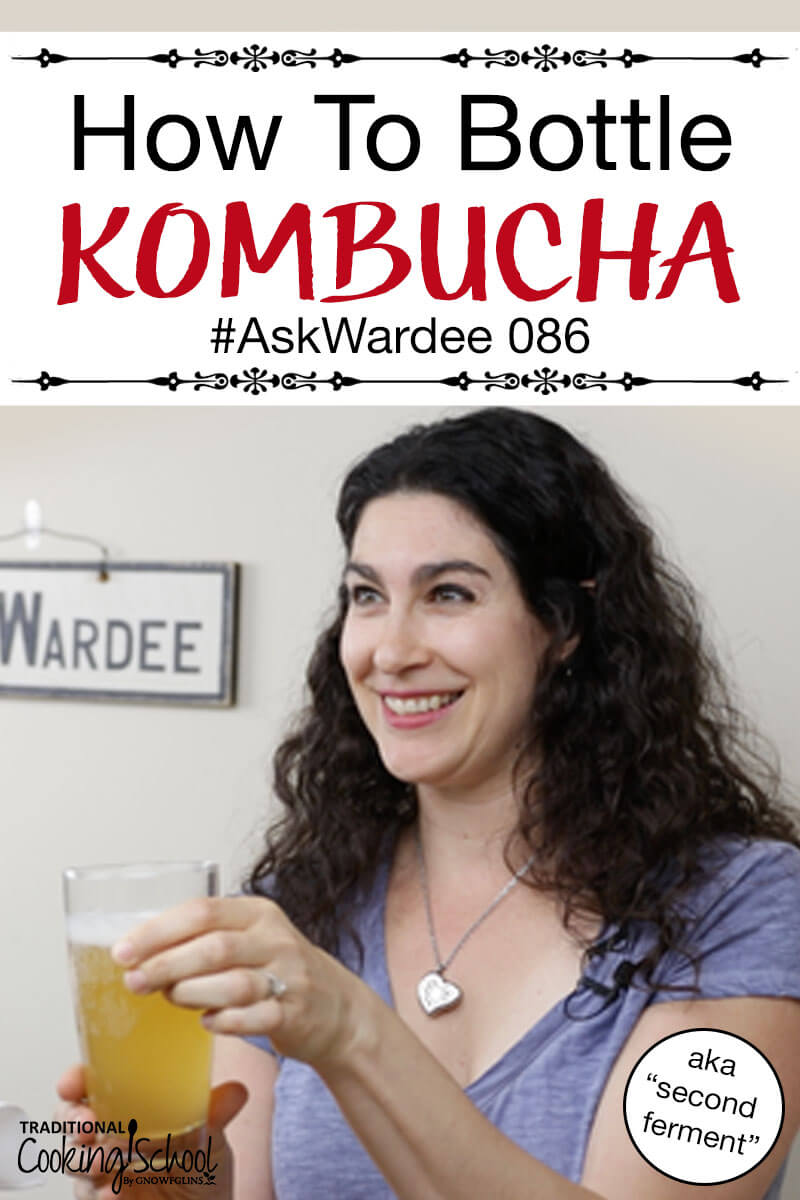
Second ferment? What’s that?
It’s when you take your finished Kombucha and bottle it, flavor it, build up carbonation… that’s the second ferment.
And, wow… it makes Kombucha sooo good and tasty and bubbly!
In the past, we didn’t second ferment, but now we always do. It’s that good!
On this week’s #AskWardee, I’ll show you how to second ferment Kombucha! Check out the particulars below in print, podcast, or video.
Subscribe to #AskWardee on iTunes, Stitcher, YouTube, or the Podcasts app.
The Question: How Do You Second Ferment Kombucha?
Christina S. asked this question ages ago:
How do you second ferment Kombucha?
My Answer
It’s really easy, and it’s so worth doing; so let’s get it into how to second ferment Kombucha!
Why Second Ferment?
Not only does bottled Kombucha get ooohs and aaahhs from family and guests, there are other reasons to love second fermented (bottled) Kombucha:
- it adds flavor(s)
- it increases carbonation
- you’ll save money over buying bottled Kombucha
- it can help wean your family off soda — not many can resist bubbly Kombucha!
- and it increases the “wow” factor of your homemade Kombucha — I mean, just look at those bottles! 🙂
To make your own bubbly beverage that your family and friends love as much as soda? It’s a rarity in today’s world — and some might say that’s reason enough for doing it! 😉 I certainly wouldn’t argue!
What Bottles To Choose
You need Grolsch-style bottles. However, it’s not enough just to look like the old fashioned bottles — the bottles have to be strong enough not to explode under the pressure of carbonation.
If purchasing new, make sure the specs say they are rated for Kombucha and other home brews. A casual bottle won’t cut it. They actually have to be tested and made for this job. I like these (light/clear) or these (dark).
If purchasing used, you’re taking a chance. The money savings may be worth it — if it actually works.
Do you know someone who brewed beer or Kombucha at home and is selling or giving away their old bottles? Ask if those bottles were strong enough. Hopefully, they’ll be honest about it!
Obviously, don’t buy bottles that have cracks or chips.
We have a set of larger bottles that we bought through a discount store for a few dollars each. They had sugary soda in them. I bought them just because I wanted the bottles. I dumped the soda, and we’ve been second fermenting Kombucha in them for years now. That was a bargain that paid off — they could easily have proven not strong enough, though.
How To Second Ferment Kombucha aka… Bottle It!
The process of bottling (second fermenting) Kombucha is quite simple:
- Complete the first ferment of Kombucha in your regular fermenting vessel — like this continuous brew system. You want it to taste great and not be too sweet. If it’s too sour, the second ferment will help sweeten it up, so that’s ok, too.
- Put 6 to 10 pieces of cut up, dried fruit in the bottom of each bottle. We love dried figs, blueberries, cherries, or cranberries; or candied ginger. (You can use fresh or frozen fruit, too… here’s how!)
- Fill the bottles to within one inch of the top with the finished Kombucha (see below for decanting methods).
- Close the bottles.
- Put the bottles in a warm location or on a seedling warming mat for 1 to 3 days.
- Refrigerate. When totally chilled, they’re ready to drink.
Yumm!!!!
Methods Of Decanting
Depending on your fermenting vessel (for the first ferment), there are multiple ways to decant the Kombucha into the bottles.
First, if it’s a continuous brew system like this, decant right from the pour spout of the large vessel into the bottles.
Second, pour the first fermented Kombucha into a glass measuring cup and pour it from there into the bottles.
Third, use food-grade tubing to transfer the first fermented Kombucha from the large fermenting vessels into the individual bottles. The downside to this is you have to “start the flow” by putting your mouth on it and sucking out the air, which creates a vaccuum for the Kombucha to start fill the tube and pouring into your bottle.
You may remember from science class how liquid finds the lowest spot. To fill a bottle, put one end of the tube inside the Kombucha fermenting vessel, then “start the flow” by sucking some air out of the other end of the tube (so it creates a vacuum for the Kombucha to start flowing) and put that end inside the bottle. Make sure the bottle and the tube inside it are below the end of the tubing that’s in the large container. To slow down or reverse the flow, raise it up. This is a fun method, but it can be messy or undesirable because 1) you have to put your mouth on the tube now and then, which isn’t ideal if you’re going to serve Kombucha to guests on a regular basis and 2) it’s easy to overflow bottles!
Fourth, you can use an (inexpensive!) automatic bottling syphon like this (pictured above) to decant fast and easily! Although it takes a bit to get the hang of it, it works a lot like #3 except you don’t have to put your mouth on any tubes so you can feel completely comfortable serving your Kombucha to family and friends. This is my son’s preferred method of decanting and I show you how to do it on #AskWardee 104.
What If It’s Too Sour?
When bottling Kombucha and opening up for a taste-test, you lose some or all of the carbonation for the time being.
So, this is where you need to develop a rhythm for your house and how long it takes your Kombucha to second ferment until it’s perfect. By the way, this can change with the seasons… faster in summer, slower in winter, due to house temperature.
If it goes too sour… no worries, you can “sweeten” to taste with liquid stevia after you open the bottle!
Additional Fermenting Articles
- Troubleshooting Your Ferments (KYF172)
- Lacto-Fermentation 101 Video Series
- Which Water is Best for Fermenting?
- Which Kind of Salt Should I Use for Fermenting?
- Do Lacto Ferments Contain Alcohol?
- Can I Use Alternative Sweeteners in Ferments?
- How to Tell if Your Kombucha is Moldy (And What to Do About It)
Helpful Links:
- How To Divide A Scoby #AskWardee 083
- Can You Make Kombucha With Honey? (Yes!) #AskWardee 085
- How To Make Kombucha
- Continuous Brew Kombucha (review)
- Where To Buy A Kombucha Scoby
- Where To Buy Bottles: these are dark and these are clear
- How To Create A Scoby Hotel
- How To Flavor Kombucha With Frozen Fruit (works with fresh, too)
- Where To Buy A Seedling Warming Mat
- Where To Buy Liquid Stevia — if you have sour Kombucha that you need to “sweeten up” without sugar!
- GAPS Articles/Archives
- FREE Fermenting Formulas Cheat Sheet
Do you second ferment your Kombucha? What flavors are your favorite? Finally, what tips would you add?
We only recommend products and services we wholeheartedly endorse. This post may contain special links through which we earn a small commission if you make a purchase (though your price is the same).

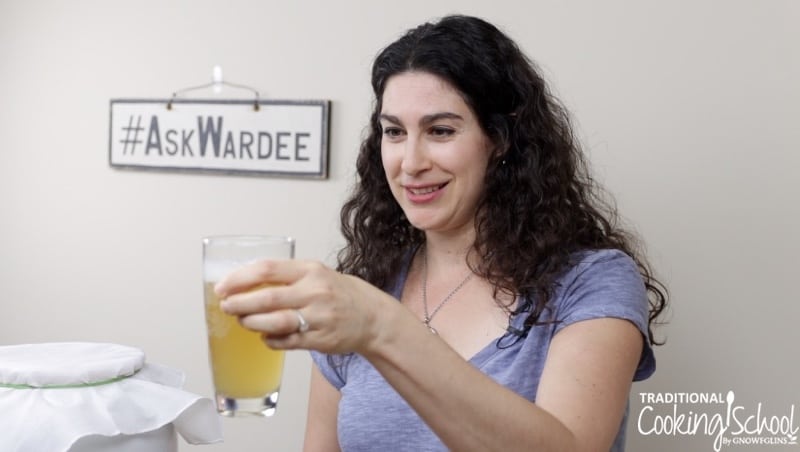
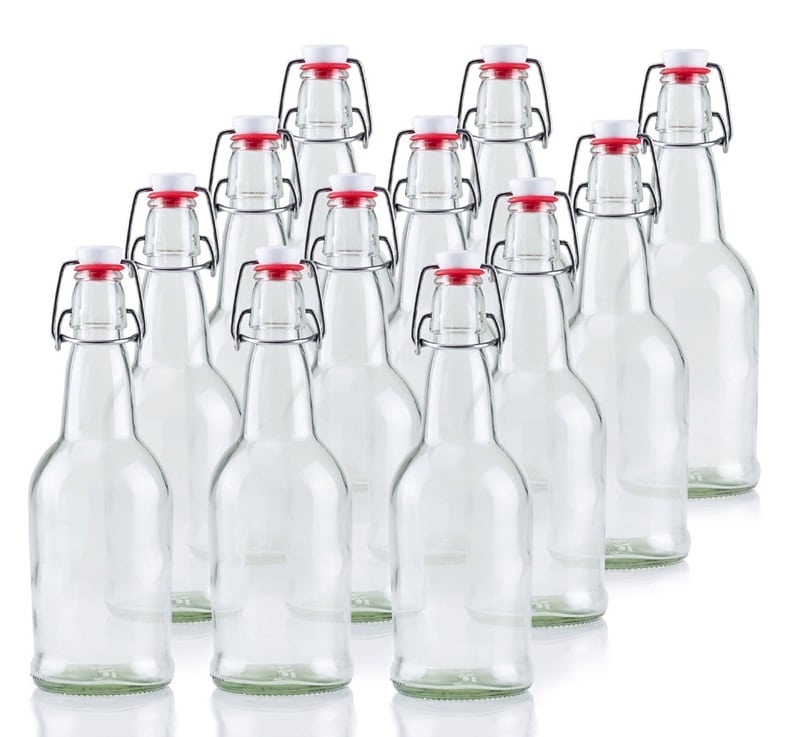
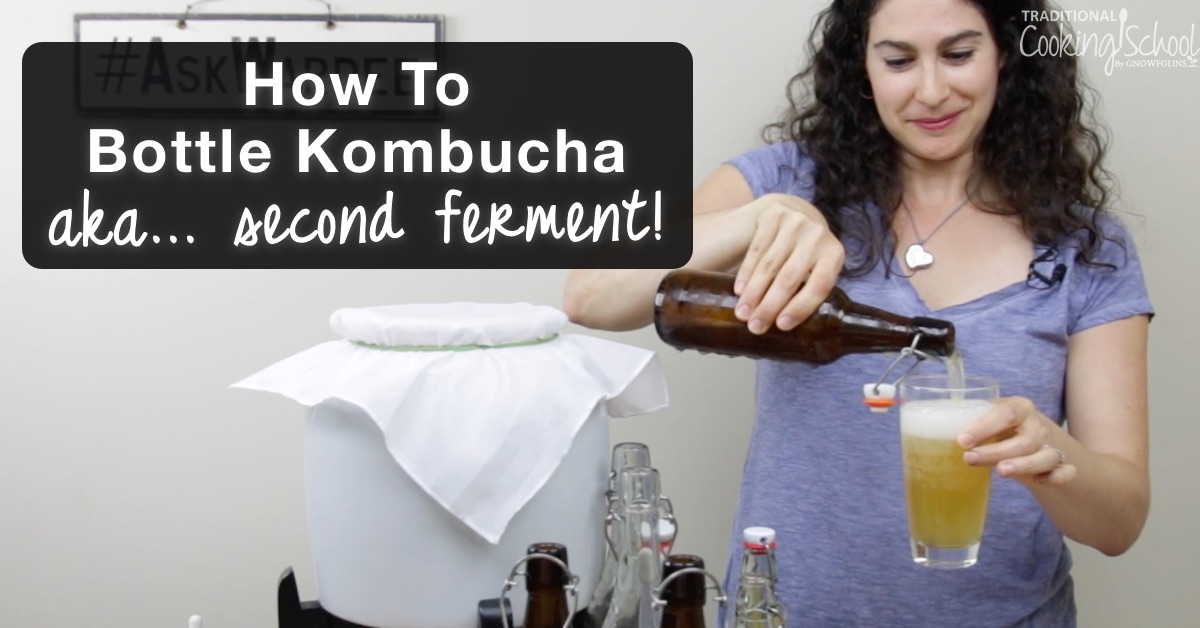
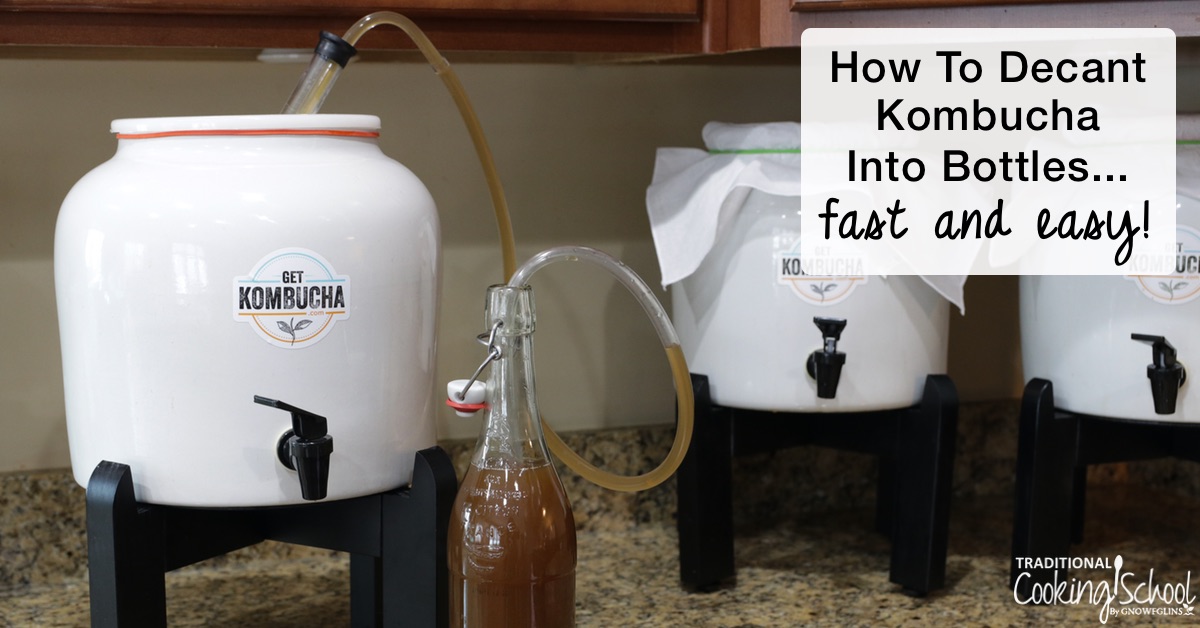

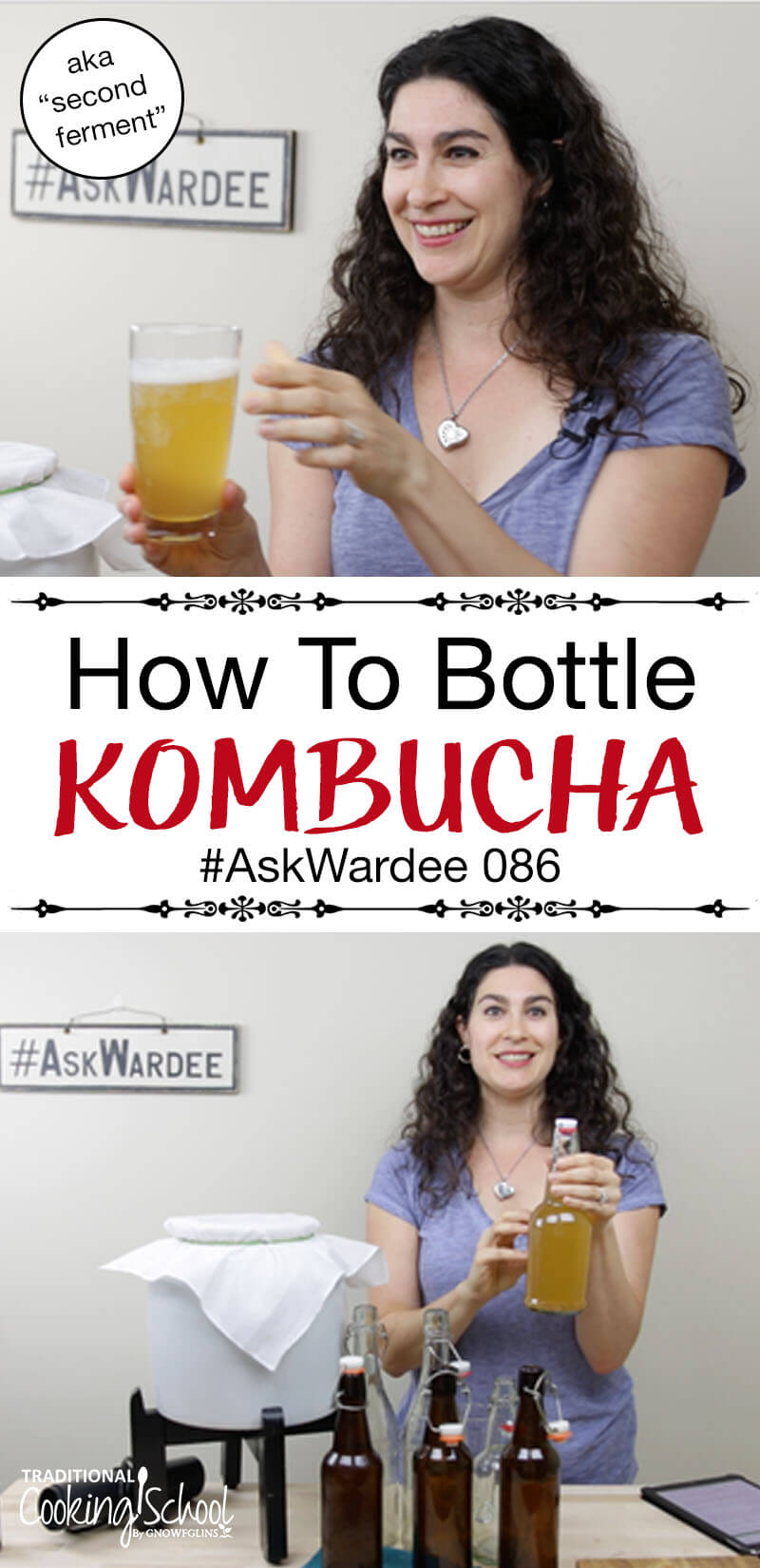
Wardeh, great presentation, as usual. Here’s a tip for opening a grolsch bottle: Turn the bottle so the side with the wire loop faces away from you. Place your thumbs on the wire circles on the back side and push. Much easier!
I find the clear bottles are much easier to use than the dark bottles because it can be hard to judge the fill level with the dark.
Also, I have been using both grolsch bottles and recycled GTs bottles for many years. Both work equally well. You can purchase replacement caps for GTs online: https://www.amazon.com/38mm-Poly-Seal-Screw-gallon/dp/B0064OFP88 These lids will last a very long time if handled with care.
A cheaper option is to replace the GTs bottle cap linings with food safe silicone. This can easily be done by cutting circles from a silicone baking mat (without fiberglass) such as this one found on Amazon:
https://smile.amazon.com/dp/B06XD6HCSF/_encoding=UTF8?coliid=I2M7ZIYG6NAEIW&colid=9OGJMZ0QMNSJ
I don’t add any fruit or other flavoring to second ferments. They still build up lots of carbonation about 99% of the time. The advantage of NOT adding any extras is that the kombucha will hold without refrigeration for a long time. I’ve had two year old kombucha that tasted really, really great. On rare occasion, when we’ve had a scorchingly hot summer, I’ve had to chill my kombucha to avoid souring, but as I said, rarely.
Can I use canning jars for my 2nd ferment?
I have 1 kombucha bottle but the rubber seal has disintegrated. Where can I purchase a replacement?
Thanks for all the great info.
Canning jars won’t build carbonation. You can find seal replacements on Amazon. See my comments and links above.
I use regular canning jars and have been for a loooong time. I’ve had better success with them than the seals on the flip top bottles. The kids on the canning jars give me the best indicator of when enough bubbles have been created because the top is firm. I will say though that I’ve had a jar here or there build too much pressure and the lid has gotten crinkled & is no longer usable. For such an otherwise economical approach I’m willing to run the risk of losing out on a metal lid here and there.
I’m glad to be proven wrong. I shouldn’t take the word of others about what will or won’t work without trying for myself. I will pass your information along. Thanks!
Thanks so much…you just saved me the expense of buying the bottles ?
Great presentation!
Naomi beat me to it, but she is exactly right in opening a wire-top bottle. Push with the thumb(s).
I was a bartender for many years and you can even learn to ‘one-hand’ the opening, especially when a dozen dry patrons are seeking your attention.
I have done my second ferment with fresh ginger that I chopped into cubes smaller than 1/4 inch and put in the freezer. I also have used frozen cranberries I purchased fresh during the holidays and froze. My grandson is requesting cherry. I always keep dried tart cherries on hand. They are processed with sugar & sunflower oil to prevent spoilage. I was wondering if the oil would be a problem with the second ferment? I intend to try dried mango soon.
Hi Carol,
Wardee has used cherries dried this way and the kombucha turned out fine. Shouldn’t be a problem. 🙂
~ Millie, TCS Customer Success Team
Thank you!
I tried the dried cherries. It was sweet but not much cherry taste. A hint of the same flavor as the cranberries but not the same. I was sadly disappointed. I will try fresh or frozen but won’t use the dried again!
Hi everyone,
I went to Holland Michigan and bought used Grolsch bottles at a pub there for 50 cents each.
They have worked really great.
Maybe any place that sells Grolsch beer would also be willing to sell the bottles?
I hope this helps someone.
I use frozen fruit much more often than fresh because I always have many kinds of frozen fruit. My favorite flavor is Paw Paw from our own trees. I chop and freeze the Paw Paw and use it year round. We also love blackberries that we pick wild. They fit in the flip top bottles better than domestic berries. We also like cranberries.
Hi Wardee! Great presentation and I know it has been a while since your posting, however, I am fairly new to making kombucha. What I like to use for flavoring of the second ferment for the water kefir and kombucha is a mix of dried flowers and fresh or frozen fruits. Some of my favorites are a combination are lavender & blueberries or blackberries, rosebuds & pomegranate, rosebuds & raspberries, hibiscus & strawberries, hibiscus & sour cherries, linden & kiwi, elderberry flowers & lemon.
Daniela,
Those sound like wonderful and fun flavor combinations. Thank you for your suggestions.
~ Vicki TCS Customer Success Team
I just finished a second fermentation, but it doesn’t have any fizz, or bubbly. Is this still good? and do I have to do a second fermentation to get the full benefits?
Hi, Shirley:
How long was your second fermentation? Sometimes it can take longer for fizziness to develop when the weather is cold. Did you add any fruit or flavorings? Those might affect the fizziness, too.
Even without fizz, the kombucha is still good as long as the culture is working (is it consuming the sweetener?). And you don’t have to do the second fermentation to read the benefits!
Sonya, TCS Customer Success Team
I have never done a second ferment for my kombucha. I used the bottles that I get my commercial kombucha to stor after first ferment. Will they work for the second fermenting process?
Yes, Kathy, you can do a second ferment in the same bottles. Just be mindful that they could get pretty fizzy, so make sure the lids are on tight or they might overflow.
Sonya, TCS Customer Success Team
I brewed my first batch of Kambucha. I did a 2nd ferment but didn’t follow the directions so it didn’t carbonate. That’s okay… it is still good.
I trying my second batch so I want to get it right.
In my first, 2nd ferment try, I noticed that it was developing a new scoby in each bottle. Do people just drink that? Because mine didn’t carbonate, I just filtered it out. But if I do get my next batch to carbonate, how can I get rid of that without releasing all the carbonation?
Thank you for the advice!
Great job Jon on your first batch! There is a little live culture in each jar that grows. Most are very small. Once you open the jar it may float to the top and you can get it out that way or drink the kombucha till you get to the bottom then pour it out. I honestly drink it down with the kombucha, great probiotics for your gut! 🙂
~Peggy, TCS Customer Success Team